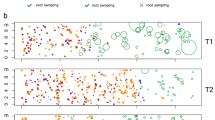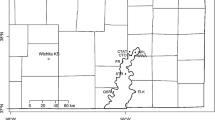Abstract
Vegetation in canopy gaps of two old-growth Abies-Betula forest stands, one with bamboo the other without, was measured. The structure of gap vegetation at each site was used to derive tree replacement probabilities. Transition probabilities indicate different tree replacement trends in forests with bamboo compared to those without. Projected compositions show Betula to be the most abundant species in bamboo stands while Abies remains most abundant where bamboo was absent. A dense bamboo sward seems to reduce the probability of Abies filling gaps by inhibiting establishment and growth of seedlings. Bamboo preempts space after canopy gap formation by increasing shoot production which reduces opportunities for establishment and growth of other woody species. Differences in dispersal ability and longevity of Abies and Betula appear to be important factors contributing to their coexistence forests with a small canopy gap disturbance regime.
Similar content being viewed by others
References
Barden, L. S. 1980. Tree replacement in a cove hardwood forest in the southern Appalachians. Oikos 35: 16–19.
Barden, L. S. 1981. Forest development in canopy gaps of a diverse hardwood forest of the southern Appalachians. Oikos 37: 205–209.
Bray, J. R. 1956. Gap phase replacement in a maple-basswood forest. Ecol. 37: 598–600.
Camphell, J. J. N. & Qin Zisheng 1983. Interactions of giant pandas, bamboo and people. J. Am. Bamboo Soc. 4: 1–34.
Cottam, G. & Curtis, J. T. 1956. The use of distance measures in phytosociological sampling. Ecol. 37: 451–460.
Ehrenfeld, J. G. 1980. Understory response to canopy gaps of varying size in a mature oak forest. Bull. Torrey Bot. Club 107: 29–41.
Foster, J. R. & Reiners, W. A. 1986. Size distribution and expansion in canopy gaps of a northern Appalachian spruce-fir forest. Vegetatio 68: 109–114.
Franklin, J. F., Maeda, T., Oshumi, T., Matsui, M., Yagia, H. & Hawk, G. M. 1979. Subalpine coniferous forests of central Honshu, Japan. Ecol. Monogr. 49: 311–334.
Grubb, P. J. 1977. The maintenance of species richness in plant communities. The importance of the regeneration niche. Biol. Rev. 52: 107–145.
Harcombe, P. A. & Marks, P. J. 1978. Tree diameter distributions and replacement processes in southeast Texas forests. For. Sci. 24: 153–166.
Horn, H. 1975. Markovian properties of forest succession. In: Cody, M. I. & Diamond, J. (eds), Ecology and evolution of communities, pp. 196–211. Belknap Press, Cambridge.
Huenneke, L. F. 1983. Understory response to gaps caused by the death of Ulmus americana in central New York. Bull. Torrey Bot. Club 107: 29–41.
Koyama, T. 1984. Regeneration and coexistence of two Abies species dominating subalpine forests in central Japan. Oecologia 62: 156–161.
Marks, P. L. 1974. The role of pin cherry (Prunus pensylvanica L.) in the maintenance of stability in northern hardwood ecosystems. Ecol. Monogr. 44: 73–88.
Nakamura, T. 1985. Forest succession in the subalpine region of Mt. Fuji, Japan. Vegetatio 64: 15–27.
Nakashizuka, T. & Numata, M. 1982a. Regeneration process of climax beech forests I. Structure of a beech forest with the undergrowth of Sasa. Jpn. J. Ecol. 35: 57–67.
Nakashizuka, T. & Numata, M. 1982b. Regeneration process of climax beech forest II. Structure of forest under influence of grazing. Jpn. J. Ecol. 32: 473–482.
Nakashizuka, T. 1987. Regeneration dynamics of beech forests in Japan. Vegetatio 69: 169–175.
Peet, R. K. 1974. The measurement of species diversity. Ann. Rev. Ecol. Syst. 5: 285–307.
Pickett, S. T. A. 1980. Non-equilibrium coexistence of plants. Bull. Torrey Bot. Club 107: 238–248.
Runkle, J. R. 1981. Gap regeneration in some old-growth forests of the eastern United States. Ecol. 62: 1041–1051.
Runkle, J. R. 1982. Patterns of disturbance in some old-growth mesic forests of the eastern United States. Ecol. 63: 1533–1546.
Runkle, J. R. 1984. Development of woody vegetation in treefall gaps in a beech-sugar maple forest. Holarct. Ecol. 7: 157–164.
Schaller, G. B., Hu Jinchu, Pan Wanshi & Zhu Jing 1985. The giant pandas of Wolong. University of Chicago Press, Chicago.
Shannon, C. E. & Weaver, W. 1949. The mathematical theory of communication. University of Illinois Press, Urbana.
Taylor, A. H. & Qin Zisheng 1987. Culm dynamics and drymatter production of bamboos in the Wolong and Tangjiahe giant panda reserves, Sichuan, China. J. Appl. Ecol. 24: 419–433.
Taylor, A. H. & Qin Zisheng 1988a. Regeneration from seed of Sinarundinaria fangiang, a bamboo, in the Wolong giant panda reserve Sichuan, China. Am. J. Bot. 75: 1065–1073.
Taylor, A. H. & Qin Zisheng 1988b. Regeneration patterns in old-growth Abies-Betula forests in the Wolong Natural Reserve, Sichuan, China. J. Ecol. 76.
Veblen, T. T., Ashton, D. H., Schlegel, F. M. & Veblen, A. T. 1977. Distribution and dominance of species in the understorey of a mixed evergreen-deciduous Nothofagus forest in south-central Chile. J. Ecol. 65: 841–851.
Veblen, T. T., Veblen, A. T. & Schlegel, F. M. 1979. Understorey patterns in mixed evergreen-deciduous Nothofagus forests in Chile. J. Ecol. 67: 809–823.
Veblen, T. T., Schlegel, F. M. & Escobar, R. B. 1980. Structure and dynamics of old-growth Nothofagus forests in the Valdivian Andes, Chile. J. Ecol. 68: 1–31.
Veblen, T. T. 1985. Forest development in tree-fall gaps in the temperate rainforests of Chile. Nat. Geogr. Res. 1: 161–184.
Waggoner, P. E. & Stephens, G. R. 1970. Transition probabilities for a forest. Nature (London) 225: 1160–1161.
Watt, A.S. 1947. Pattern and process in the plant community. J. Ecol. 35: 1–22.
White, P. S., Mackenzie, M. D. & Busing, R. T. 1985a. A critique of overstory/understory comparisons based on transition probabilities of an old growth spruce-fir stand in the Appalachians. Vegetatio 64: 37–45.
White, P. S., Mackenzie, M. D. & Busing, R. T. 1985b. Natural disturbance and gap phase dynamics in southern Appalachian spruce-fir forests. Can. J. For. Res. 15: 233–240.
Williamson, G. B. 1975. Pattern and seral composition in an old-growth beech-maple forest. Ecol. 56: 727–731.
Author information
Authors and Affiliations
Rights and permissions
About this article
Cite this article
Taylor, A.H., Zisheng, O. Tree replacement patterns in subalpine Abies-Betula forests, Wolong Natural Reserve, China. Vegetatio 78, 141–149 (1988). https://doi.org/10.1007/BF00033423
Accepted:
Issue Date:
DOI: https://doi.org/10.1007/BF00033423




